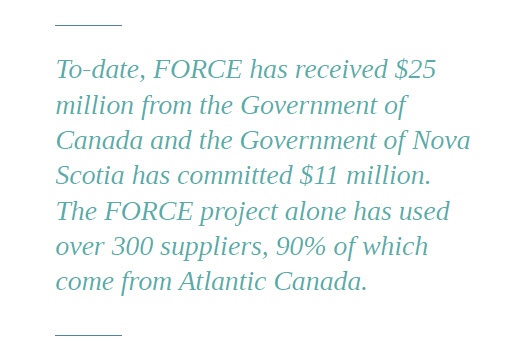Interview with FORCE - Canada
|
|
TONY WRIGHT
GENERAL MANAGERFORCE |
 What was the motivation and the driving forces to build FORCE and what milestones were set up for its development? To date, how much funding (public and private) has been granted for its creation and operation?
What was the motivation and the driving forces to build FORCE and what milestones were set up for its development? To date, how much funding (public and private) has been granted for its creation and operation?
|
FORCE was established to serve as demonstration facility for in-stream tidal energy technologies in an effort to assess whether tidal energy can play a role in Nova Scotia’s energy future. Nova Scotia has strong motivations: imported fossil fuel is responsible for up to 75% of the province’s electricity generation. FORCE was established by contributions from the Government of Canada, the Province of Nova Scotia, and Encana Corporation. To-date, FORCE has received $25 million from the Government of Canada and the Government of Nova Scotia has committed $11 million. In addition, FORCE’s ‘berth holder’ companies make a onetime capital contribution to FORCE of $1 million and pay berth fees to support ongoing operations, research, and monitoring. |
 |
Milestones:
- FORCE received its Environmental Assessment Approval in 2009 and was home to Canada’s first deployed in-stream tidal turbine that year
- FORCE completed the construction of its onshore facility in 2011, onshore substation in 2012, subsea data cable installed in 2013, and four subsea electrical cables completed in 2014. The first grid-connected device was deployed in November 2016, by Cape Sharp Tidal Ventures.
 It is recognised that test centres can be instrumental in proving the technology can work in challenging marine environments. What other benefits do you see for developers and also for local/regional communities?
It is recognised that test centres can be instrumental in proving the technology can work in challenging marine environments. What other benefits do you see for developers and also for local/regional communities?
For Nova Scotians, tidal energy provides clean electricity to Nova Scotians (tidal energy more predictable source of renewable electricity). The FORCE project also provides local economic benefits: research, construction, hospitality and building on existing ocean technology expertise.
The FORCE project alone has used over 300 suppliers, 90% of which come from Atlantic Canada.
FORCE’s Visitors Center also serves as an eco-tourism opportunity. Since 2011, FORCE has welcomed over 24,000 visitors. As a test center, FORCE provides a lower cost option for developers by having infrastructure and an Environmental Assessment Approval in place. For the scientific community, the project is responsible for advancing the understanding of the Minas Passage in the Bay of Fundy in terms of both physical and biological characteristics, it has also been an opportunity for the region’s ocean sensing community, providing a high flow testing ground for acoustic and optical instrumentation and deployment and recovery methods.
 For ocean energy in general, do you think test centres have a role to play on giving international visibility to the sector? Do you see improvement potential in this respect, and have suggestions?
For ocean energy in general, do you think test centres have a role to play on giving international visibility to the sector? Do you see improvement potential in this respect, and have suggestions?
An opportunity to combine infrastructure, supply chain, research, monitoring and engagement is both efficient and effective, and has the potential to raise the overall awareness/profile of the sector.
 There are several test centres around the world, how do you see the possibility of knowledge sharing between these test centres? Apart from technology-specific details that are usually under non-disclosure, what information could be shared to support the sector?
There are several test centres around the world, how do you see the possibility of knowledge sharing between these test centres? Apart from technology-specific details that are usually under non-disclosure, what information could be shared to support the sector?
Yes, test centers (esp. at this early stage) must work together. FORCE has had an ongoing relationship with EMEC in Scotland for years. Right now, we’re looking at the difference in corrosion and underwater behaviour of marine coatings on either side of the Atlantic Ocean. This cooperation provides an opportunity to learn lessons based on one another’s experience, share resources, and support innovations. Perhaps the most vital information sharing is around understanding and responding to potential environmental effects. To secure both public and regulatory support, it’s vital that all test centres target areas of uncertainty, monitor, and share results. There are other areas – such as deployment, mooring, O&M, cable interconnection – that will all benefit from the development of standardization and best practices, but many of these areas understandably still remain under IP protection as they evolve.
 Would you like to mention any key lessons from your experience over the operation of the test centre? Have expenses kept reasonably within foreseen limits, or were there any major unforeseen challenges?
Would you like to mention any key lessons from your experience over the operation of the test centre? Have expenses kept reasonably within foreseen limits, or were there any major unforeseen challenges?
There are a number of challenges working at our site. First, the extreme high flows. We have managed to build our facility within budget, but this required a very active evolution in understanding and retiring marine operational risks. Smaller is better, but every operation requires safety and redundancy – understanding what’s possible has taken many hours of trial and error on the water. Ideally, you want to develop a group of marine suppliers that can be involved frequently and repeatedly – you can never get enough practice deploying and recovering marine assets in an environment like ours.
The other major lesson is level of engagement. While we spent considerable effort to build relationships within the area where we work, the project faced a legal challenge from lobster fishers that were approximately 100km away. It’s vital that the broader marine community be engaged regularly and comprehensively during all stages of the project, both to share project-specific information, as well as hear their concerns. The industry will only work if it can co-exist with other users, and so fishers, First Nations, and other communities with a longstanding connection to the marine system need to be meaningfully involved – not only at the start, but at every stage.
Finally, as mentioned earlier, there must be a concerted effort to collect, interpret, and share data related to any environmental effects. While the work done to date has been encouraging, far more needs to be collected. The public and regulators will need convincing evidence that any effects are both known and acceptable if the technology is to move to larger-scale.




